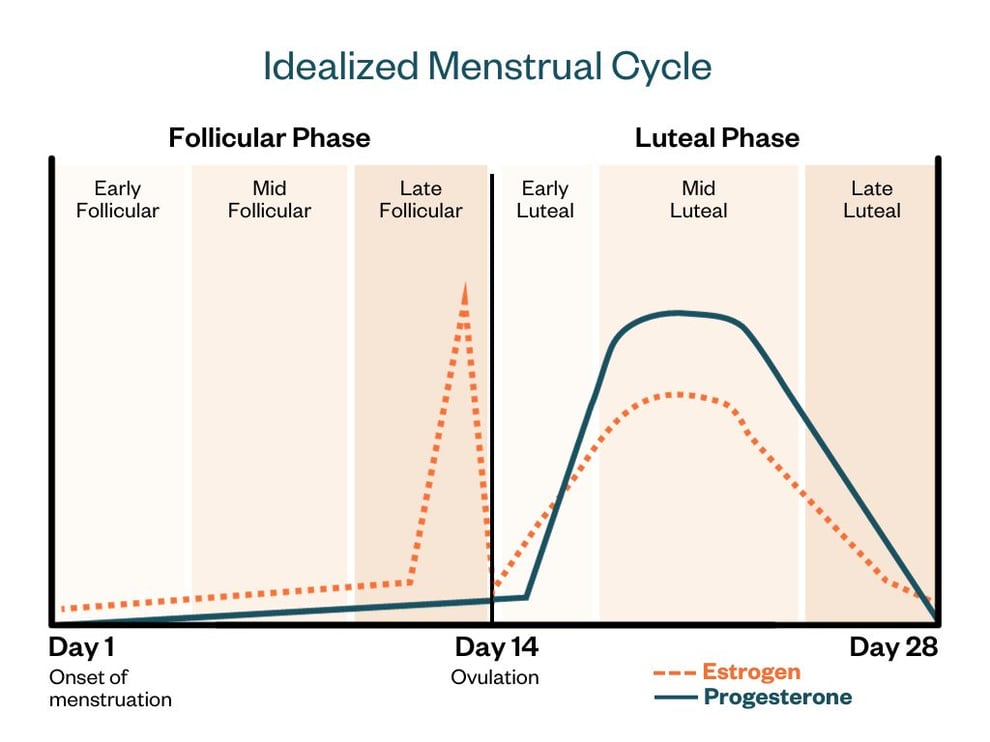Go With The Flow
When it comes to our menstrual cycles, most of us can say we have experienced the common symptoms before our periods: fatigue, bloating, mood swings, cramping, and so on. In fact, according to the Office on Women’s Health, over 90% of women endure these premenstrual symptoms, also known as PMS. Focusing on your food may be one way to help ease some symptoms. Introducing the method known as Cycle Syncing! This method syncs your food choices with the current phase of your menstrual cycle, improving energy levels, mood swings, and helping to regulate several premenstrual symptoms.
The Menstrual Cycle: A Refresher
The menstrual cycle is a recurring series of physiological changes that affect a woman’s reproductive system, caused by changes in hormone levels. An average cycle – which starts on the first day of menstruation - lasts around 28 days from start to finish, though anywhere from 21 to 35 days is considered typical. It includes 2 phases: follicular and luteal, and 2 processes: menstruation and ovulation. Starting day 1, the uterine lining is shed by menstruation, commonly referred to as your “period,” which signifies the start of the follicular phase. Around day 14, ovulation kicks off the luteal phase, during which the uterine lining continues to grow to support a potential embryo. At the end of this phase, if the woman’s egg is not fertilized, the cycle starts all over again with her period. The menstrual cycle is controlled by estrogen and progesterone, hormones that the body produces. Food can affect the production and secretion of hormones, hence why cycle syncing can be so important for regulating your menstrual cycle!

Understanding Your Cycle
Menstruation
The menstrual process or “period” typically occurs days 1 through 5 of your cycle, but it can be up to 7 days. The uterine lining is shed by vaginal bleeding, the body’s natural response to no pregnancy taking place.
Menstruation can cause a depletion of iron in the blood. In a 2023 study on the prevalence of iron deficiency,1 it was discovered that almost 40% of girls 12-21 years old living in the United States are iron deficient. This can result in symptoms that include fatigue, headache/lightheadedness, dizziness, pale skin, brittle nails, and shortness of breath.
What you can do:
- To avoid these symptoms, it is important to eat foods rich in iron, including dark leafy greens like spinach, lean meat such as chicken or turkey, shellfish, lentils, and beans.
- To increase iron absorption, combine these foods with vitamin C sources, such as citrus fruits, kiwi, broccoli, and red peppers.
- Also remember to always drink plenty of water, especially during your period, because it can reduce “dehydration headaches” and bloating, two common menstruation symptoms.
Follicular Phase
The follicular phase usually occurs from the start of your period up to day 14. After menstruation, your estrogen levels start to rise, which signals your endometrial lining to start growing again. The lining thickens in order to prepare for a potential pregnancy, when a fertilized egg or embryo would implant itself in the uterine lining for further development.
During the follicular phase, “your body tends to rely more on carbohydrates for energy versus fat or protein,” according to Kathy Brown, a registered dietician from Phoenix, Arizona specializing in Women’s Health. Your body needs to replenish its stores, which might be why you experience those bread and pasta cravings!
What you can do:
- Brown recommends eating complex carbohydrates including whole wheat bread, brown rice, quinoa, fruit, and starchy vegetables like potatoes. Consuming complex carbs will provide your body with sustained energy and won’t spike your blood sugar, in comparison to simple carbs.
Ovulation
Typically on days 14-15 of the menstrual cycle, ovulation occurs when a new egg is released from the ovary and travels into the fallopian tube where it can be fertilized.
Right before ovulation, estrogen hormone levels peak, causing energy levels to be the highest during this time. According to a 2013 report on the role of estrogens in energy balance and glucose metabolism,2 estrogen acts on the neurons in the hypothalamus of the brain to stimulate energy expenditure and physical activity. Therefore, as estrogen levels rise, we feel an increase in our energy.
What you can do:
- In order to sustain this energy increase, it’s recommended for women to eat foods that have a low glycemic index and/or contain monounsaturated and polyunsaturated fats, antioxidants, and vitamins.
- Low glycemic index foods include whole grain breads or pastas (minimally processed), fruits, vegetables, beans, nuts, and low-fat dairy products. The lower the glycemic index, the slower our bodies can convert food into glucose for energy. This prevents blood sugar/glucose spikes and provides women with sustained energy throughout their day!
- A 2017 Harvard review on the relationship between diet and fertility3 found that polyunsaturated fats can positively affect developing eggs and embryo implantation. One highly recommended polyunsaturated fat to include in your diet is omega-3 fatty acids. These fatty acids are used mostly for building cell membranes, but they can also increase production of nitric oxide in blood vessels, lowering blood pressure. Omega-3 fatty acids can be found mostly in seafood including salmon, mackerel, herring, sardines, as well as flax seeds and walnuts.
- Antioxidants have been found to protect the quality of eggs by fighting free radicals and regulating menstrual cycles, according to the American Pregnancy Association. The foods highest in antioxidants include berries, beans -especially red beans - dark chocolate, and dark leafy greens.
Luteal Phase
The luteal phase takes place after ovulation, typically between days 14 to 28. During the luteal phase, progesterone hormone levels rise, which stimulates gland and blood vessel development for embryo implantation.
In this phase, the female body uses more fats for energy and breaks down protein faster. Women also can experience premenstrual symptoms (PMS) during this time, including abdominal pain, change in appetite, and mood swings.
What you can do:
- Healthy fats and proteins – needed for energy - can be obtained by eating fish, particularly salmon which is rich in omega 3-fatty acids and high in protein. Nuts and avocados are also rich in healthy fats as well. If you are vegan, another high protein option to consider is tofu or white beans, which are high in calcium as well!
- Also, we have great news for our sweet-toothed ladies… dark chocolate has been found to lower cortisol levels! Increased cortisol levels, in response to stress, can worsen anxiety symptoms, hence why we want to keep these levels low. In a 2018 study on the relationship between the menstrual cycle and cortisol secretion,4 evidence indicated that a woman’s cortisol response can be influenced by which phase of the menstrual cycle she is in. In the study, women were found to be more reactive, ie produced more cortisol in response, to laboratory-induced stress during their luteal phase, compared to their follicular phase. According to a 2019 study on the effect of dark chocolate on cortisol and mood,5 subjects ingesting dark chocolate with a high concentration of flavonoids saw reductions in total daily cortisol, as compared to a control group. So, if you’re craving a sweet treat during your cycle, you might want to consider having some dark chocolate next time!
- Consider your calcium intake. Not only is calcium important in bone health, in a double-blind clinical trail,6 it was discovered that a daily intake of 500 mg of calcium supplements can reduce PMS-related mood disorders.
Conclusion
To keep track of what part of the menstrual cycle you’re in, you may want to keep a journal or mark up a calendar. By tracking your period at the beginning of your cycle, you will be able to predict your next ovulation, around day14, and period, around day 28. Between these events you’ll also know whether you’re in your luteal or follicular phase. In addition, you can track your mood, energy levels and/or PMS symptoms to see what patterns arise. By knowing what part of our cycles we’re in – and how we’re affected - we can choose the right foods to fuel our bodies to the max! And those food cravings? Well, maybe we should listen to those as well. Our bodies know what they want and what makes them feel the best!

References
Premenstrual syndrome (PMS) | Office on Women’s Health. Page last updated February 22, 2021.
Bourgeois, C. R. (2023, May 30). What to eat during each stage of your menstrual cycle. Forbes Health.
Ferguson, S. (2023, February 21). What to eat during your period: Fish, leafy greens, yogurt, and more. Healthline.
Meletis, C. D. (2022, June 17). Boost your fertility with supplements. American Pregnancy Association.
Footnotes
1. Weyand, A. C., Chaitoff, A., & Freed, G. L., et al. (2023, June 27). Prevalence of iron deficiency and iron-deficiency anemia in US females aged 12-21 years, 2003-2020. JAMA.
2. Mauvais-Jarvis, F., Clegg, D. J., & Hevener, A. L. (2013, June). The role of estrogens in control of energy balance and glucose homeostasis. Endocrine reviews.
3. Gaskins, A. J., & Chavarro, J. E. (2017, August 24). Diet and Fertility: A Review. American Journal of Obstetrics & Gynecology.
4. Montero-López, E., Santos-Ruiz, A., García-Ríos, C., Rodríguez-Blázquez, M., Rogers, H. L., & Peralta-Ramírez, M. I. (2018, September). The relationship between the menstrual cycle and cortisol secretion: Daily and stress-invoked cortisol patterns. International journal of psychophysiology : official journal of the International Organization of Psychophysiology.
5. Tsang C, Hodgson L, Bussu A, Farhat G, Al-Dujaili E. Effect of Polyphenol-Rich Dark Chocolate on Salivary Cortisol and Mood in Adults. Antioxidants (Basel). 2019 May 29;8(6):149. doi: 10.3390/antiox8060149. PMID: 31146395; PMCID: PMC6616509.
6. Shobeiri, F., Araste, F. E., Ebrahimi, R., Jenabi, E., & Nazari, M. (2017, January 15). Effect of calcium on premenstrual syndrome: A double-blind randomized clinical trial. Obstetrics & gynecology science.





